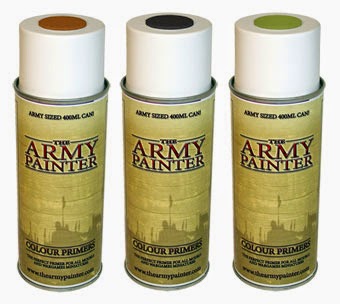No matter what model you are painting they all start the same way, with a coat of primer. Today we have Part 2 of my look at your primer choices.
Last week in Part 1 I went over some basics of the importance of using primer, the best companies to choose from and the advantages and disadvantages of black and white primer. Today I am going to look at some of the other choices of primer colors available as well as a few more tips and tricks.
I recently came across this primer while working on a fairly large commission that required a lot of grey. Luckily for me I found this primer by Tamiya that almost perfectly matched the color I was using. I went through maybe 3 cans while working on the commission and was pleasantly surprised with how it worked. It sprays evenly, thinly and with no dusting, its also fairly cheap depending on where you buy it at. I found mine at a certain craft store that frequently has coupons and discounts. I now use this as my alternative for white primer since it is fairly light and covers much better than any cans of white I have found so far.
This guy right here was primed with Tamiya Grey Primer and then worked up to white. It actually works better since you don't really want to use flat white for your main color since it leaves you no room to highlight. His base color is Ulthuan Grey, which is slightly off white which I can than highlight with pure white. This of course would not work for tricks such as using a yellow wash right over a white primer to get a good yellow color but for anything else that needs a light primer base I highly recommend it. It is also more neutral then white.
The next choice you have is a colored primer. There are several companies that make them, including GW (although their selection is very limited) but I prefer Army Painter due to their consistent quality, vast range of choices and the fact that they color match all of their primers with a regular layer paint. I started using this range for my Tomb Kings.
Originally I had a white primer since my guys are mostly bone and other light colors like white and gold, but wasn't satisfied with the consistency of the primer. Sometimes I would get a chalky coat other times a really thin transparent coat. Then I decided to try Army Painter's Bone colored primer and all of my problems were solved. It cut out a few steps for me since I no longer had to basecoat the model with bone and was all around a much better primer choice. Like I said, there is a large range of choices for colors, so more likely then not you will find a can that suits your army or project.
This model was painted using a primer basecoat of the Army Painter Bone and then made yellow by glazes. You can find the painting guide here. This just goes to show that sometimes these color primers are good for more then just the color they are.
Primer Tips
That covers all the 4 basic choices for primer so now lets go over a few extra tips. Make sure you read the instructions on each can, since they will all differ slightly. I have made the mistake of treating each can the same and that can give you bad results if you're not careful. When I first started in the hobby I would just lay my models down on some newspaper to prime them, and while I still do this for large things such as tanks and such I now use a much more efficient method for anything smaller.
I now use an old spray can that is empty and stick my model to the top of it with some poster tack. This way I can get all angles of the model in one go by turning the can around and also avoid getting any on my hands. Another good method for batch priming lots of models in one go is to find a long wooden square stick and using double sided tape to stick as many models as you can to all 4 sides. This gives you the same ease of use as my spray can idea but you get a lot more done at one time. Of course only do this for plastic or resin models since anything heavier may not stick to the tape when you turn it upside down.
If you miss a few spots don't worry to much, you can always cover them with a thin layer of paint before you start painting. It better to do this then to over spray and end up with to thick of a coat. Now this only covers spray primers, there are also paint on primers (GW's Ceramite White) and gesso, which I have not tried on a model but have heard works well also. By doing either of these methods you are just sacrificing some extra time as well as a possibly uneven coat if you're not careful.
That wraps it up for my look at choosing the right primer. As with anything like this there are many other brands, colors and choices out there that I might not even know about so if you have some tips and tricks that I missed please feel free to share it in the comment section.
Until next time,
Tyler M.







.JPG)
No comments:
Post a Comment